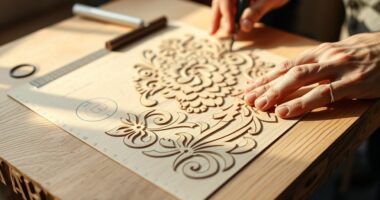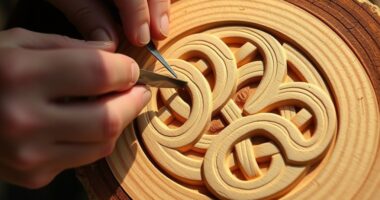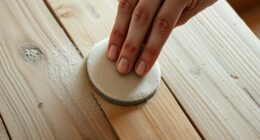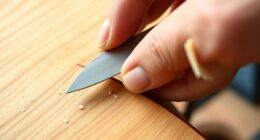To keep your carving tools razor-sharp, hold the strop at a shallow 15–20° angle and use gentle, controlled strokes, alternating sides after each pass. Make certain you’re pressing evenly and moving away from your body to stay safe. Keep your workspace clean and avoid over-stropping, as it can round the edge. Proper technique and regular maintenance will extend your tools’ life—continue exploring these key methods for excellent results.
Key Takeaways
- Hold the knife at a shallow 15–20° angle to ensure effective and safe stropping.
- Use gentle, controlled strokes, flipping sides after each pass for balanced edge honing.
- Maintain contact with the entire blade length, applying consistent pressure during each stroke.
- Inspect the edge regularly for smoothness or sheen, and avoid over-stropping to prevent dulling.
- Store the strop in a dry, safe place and keep it clean to preserve leather quality and honing effectiveness.

A sharp knife is essential for precise cuts and safe handling, and one of the best ways to maintain its edge is through proper strop techniques. When you’re honing maintenance your carving tools, you’re not just sharpening the blade; you’re ensuring it performs ideally with every use. Proper stropping aligns the microscopic metal fibers on the edge, smoothing out any microscopic burrs that develop during cutting. This process extends the lifespan of your knife and keeps it razor-sharp. To do this effectively, you need to develop a consistent technique that emphasizes safety precautions, since handling sharp blades always carries some risk.
Start by selecting a high-quality strop, preferably one with a smooth leather surface. Before you begin, make sure your workspace is clean and free of distractions. Always keep your fingers away from the blade’s edge, and hold the knife firmly but comfortably. When you position the blade on the strop, keep the edge at a shallow angle—around 15 to 20 degrees—so that you contact the entire length of the blade evenly. Use gentle, controlled strokes, moving the knife away from your body and maintaining consistent pressure. This avoids accidental slips and ensures even honing maintenance across the entire edge.
Choose a smooth leather strop, keep your workspace clean, and hold the knife firmly at 15–20 degrees for safe, effective honing.
It’s important to develop a rhythm that balances pressure and movement. Too much force can dull the blade or damage the strop, while too little might not effectively realign the edge. Typically, you should make about 10 to 15 strokes per side of the blade, flipping the knife to alternate sides with each pass. Keep your strokes smooth and deliberate, avoiding any jerky movements that could cause the blade to slip or your fingers to come into contact with the edge. Remember, safety precautions are paramount—never rush the process, and always keep your fingertips clear of the path of the blade. Additionally, incorporating regular maintenance practices can help sustain the sharpness longer.
After stropping, inspect the edge carefully. You might notice a slight sheen or feel a smoother surface along the blade’s edge. If needed, repeat the process a few more times, but avoid over-stropping, which can round off the edge. Proper honing maintenance through regular stropping helps you preserve that razor-sharp precision, making every cut cleaner and safer. Always store your strop in a safe, dry place and avoid exposing it to moisture, which can damage the leather surface. By following these techniques and safety precautions, you’ll keep your carving tools in prime condition, ready for precise, clean cuts every time.
Frequently Asked Questions
How Often Should I Strop My Carving Knives?
You should strop your carving knives regularly to maintain their sharpness, ideally after each use or when you notice a slight dullness. Remember, honing realigns the edge, while stropping polishes it for smooth cuts. Choose the right strop material, like leather or balsa wood, for superior results. Frequent stropping keeps your knives razor-sharp, ensuring precise carving without unnecessary wear.
Can I Use Synthetic Leather for Stropping?
Yes, you can use synthetic leather for stropping, and it’s a good option for durability. Synthetic leather offers consistent stropping surface and tends to be more resistant to wear, extending your stropping durability. Just make certain the surface is smooth and free of deep scratches to maintain sharpness. Regularly check and clean it to keep your carving tools razor-sharp, helping you achieve precise cuts every time.
What’s the Best Angle for Stropping Different Blades?
They say, “A little pressure goes a long way,” and that’s true for stropping. You should hold your blade at a consistent angle, usually around 15-20 degrees, to maintain proper blade alignment. Too steep or too shallow influences sharpness. Apply gentle, even stropping pressure, and keep the angle steady as you glide the blade along the strop. This ensures a razor-sharp edge without damaging your tool.
How Do I Maintain My Leather Strop?
To maintain your leather strop, regularly apply a leather conditioner to keep it supple and prevent cracking. Use quality stropping materials like honing compounds or pastes for ideal results. Avoid excessive moisture, which can damage the leather, and keep the strop clean by wiping it down after each use. Proper maintenance ensures your strop remains effective, helping you achieve razor-sharp edges with every stroke.
Can I Over-Strop and Damage My Blades?
You might wonder if you can over-strop and damage your blades. If you use proper stropping pressure techniques and verify strop material compatibility, you minimize the risk. Applying too much pressure can dull or chip your blade, so gentle, consistent strokes are key. Always check your strop material and adjust your technique accordingly. With careful stropping, you’ll maintain that razor-sharp edge without risking damage.
Conclusion
Now, as you perfect your knife strop techniques, remember that every careful stroke brings you closer to that razor-sharp edge. It’s almost poetic how a simple act of honing can transform your work and your confidence. Sometimes, it feels like these small, deliberate movements align just right, turning routine into artistry. Keep practicing, and you’ll find that the perfect carve is just a strop away—proof that patience and skill truly go hand in hand.









